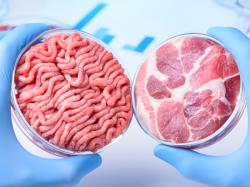Moving 'Clean Meat' From Lab To Table
October 24, 2018 | 2 min to read

"Clean meat," or meat produced from cultured animal cells, promises enormous benefits for animal welfare and the environment. But to deliver on this promise, clean meat start-ups face many challenges, both technical and in the realm of consumer acceptance, according to an article in Chemical & Engineering News (C&EN), the weekly news magazine of the American Chemical Society.
In 2013, Mark Post of Maastricht University made world headlines when he debuted the first example of clean meat — a hamburger made of cells from a cow's shoulder that required 2 years, hundreds of petri dishes and $325,000 to make. After this proof of concept, many start-up companies jumped on the bandwagon, Senior Business Editor Melody Bomgardner writes. However, numerous challenges lie ahead on the road to commercialization, including product naming and labeling, consumer acceptance and the need for new technologies to massively scale-up production and make cost-competitive, flavorful foods.
To begin with, the industry needs to agree on a name for the new products. Possibilities being discussed include "cultured meat," "in vitro meat," "cell-based meat" and "clean meat" (a popular term because it communicates environmental benefits). Most proponents want to avoid any connotations that the meat is synthetic or artificial because that could alienate consumers. An even bigger challenge is scaling up production from petri dishes to large fermentation tanks, which likely would involve finding cheaper, animal-free growth media, appropriate cell types and a scaffolding material to structure the meat. Also, clean meat companies must demonstrate that the product is as safe and flavorful as the real thing. For now, the clean meat industry isn't setting its sights on completely replacing conventional burgers and steaks — just on capturing a small percentage of the $1-trillion-per-year combined meat, poultry and seafood market.
Source: American Chemical Society
